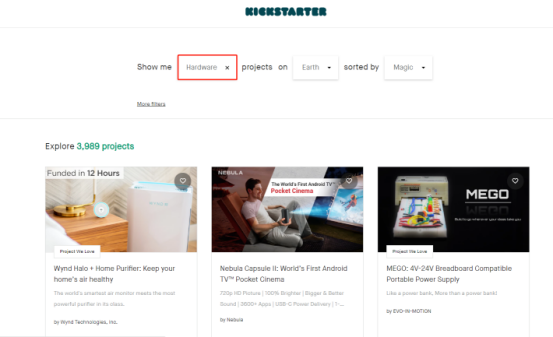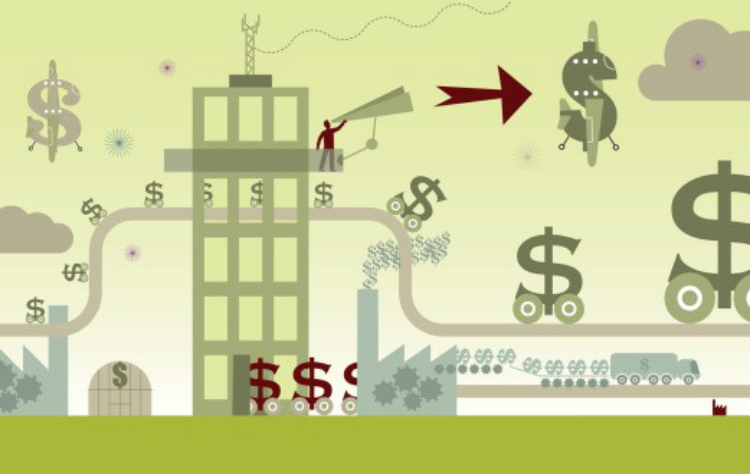Many customer ask for electronic components samples from us, and they basically come from crowdfunding platform. Our company is also very valued for such users, generally we will send them free samples + free postage. If you belong to such a startup at crowdfunding platform, you can apply for it for free too. These customers also gave us a lot of information about the crowdfunding platform.
If you have a very good hardware project but don’t know if it has market value, you can post your project on these professional crowdfunding platforms below:
1. Kickstater
For hardware enthusiasts and startups, Kickstarter has not only provided visibility, but also better tools to help entrepreneurs get to market faster on a shoestring budget, serving as both a sales channel and a funding pipeline.
Kickstarter is geared more toward creative projects like a new album or writing a book, as well as products and inventions like a personal single-wheel vehicle or a pocket-sized solar charger. Hardware project is one category of kickstater, but it’s very important category. (Kickstater cooperate with digikey to help Hardware Startups)

2. Indiegogo
In Indiegogo, you can use it to start up any project or idea. You can set up nonprofits on the site. Indiegogo also offers Flexible Funding, which means you get to keep the funds you raised, even if you didn’t reach your goal. And, since we published this last year, Indiegogo now allows you to buy funded products on their marketplace. (Indiegogo cooperate with Arrow electronics to server hardware startups.)
If you want to launch a project in indiegogo, you can see this support article:
3. Crowd supply
This is a only hardware platform, Crowd Supply is a full-service storefront and crowdfunding platform for new, cutting-edge hardware and manufactured goods. Crowd Supply is a two-sided, worldwide marketplace that has helped hundreds of creators launch, fund, ship, and continue to sell their original products. With offices and warehouses in Portland, Oregon, Crowd Supply accepts projects and sells products around the world. Crowd Supply was founded by MIT graduates to enable engineers and product designers to go from early prototypes to delivery of final products to actual customers. Every project ever funded on Crowd Supply has delivered product to its backers. (Crowd supply cooperate with digikey to help Hardware Startups)
Read carfully for the detail:
4. Patreon
Patreon is special, we test this platform and add our project in this platform, it’s very simple, everyone can add their projects. Even though it’s not a project. But the platform crowdfunding may not so much. Patreon is a membership platform that makes it easy for artists and creators to get paid. It operates a platform that enables content creators, as well as artists, to be able to fund their work. It’s Patreon.com, a communications platform, enables connection between users and makes various accessible content, including videos, photographs, images, artwork, graphics, audio clips, comments, data, text, software, scripts, projects, other material and information, and associated trademarks and copyrightable works.
Patrons pledge to support artists and creators on a recurring basis for each work created, empowering a new generation of creators the ability to make a living off of their passions.
These four platform are very good for hardware startups. You can launch your project on these platform, but you can’t make sure you can raise enough money you want. There are some tips for you by John Teel:
Market Proof and Exposure
Most entrepreneurs are so focused on raising money that they forget two of the biggest advantages of crowdfunding: gaining market proof and exposure. It’s impossible for a founder to really know if a product will sell well or not. No one can know the answer.
The only way to truly answer that question is by offering the product to the target money in exchange for money. If this is successful then you have obtained market proof that your product will sell well.
You may think that you already have market proof because everyone you talk to raves about your product. But here’s the thing about market feedback — unless money exchanges hands the feedback you receive is pretty useless.
In fact, I believe it can be worse than useless. Unrealistic feedback can be downright dangerous because it elevates your expectations to unrealistic levels.
With crowdfunding, people are investing their hard earned money because they like your product. That’s real market proof. You can then use this market proof as a catalyst to gain customers, manufacturers, and other investors.
Another benefit of a crowdfunding campaign is that your product gets early market exposure. If your campaign is a big success you can gain some really significant exposure.
Build an audience
The only way you can succeed with a crowdfunding campaign is to drive lots of highly interested people to your campaign. Any successful crowdfunding campaign needs a boost to get it moving.
Total strangers will never be the first people to invest. They need to see the momentum of other people investing first.

But how can you drive masses of people to your campaign that are interested in your product? You can start by asking your friends and family to invest, but you’ll likely still need an additional boost.
Begin building an online audience from day one. As soon as you’ve solidified your product concept you can start creating an audience of interested people.
First, build a simple website and start collecting email addresses. Ask visitors to give you their email address in exchange for something of value that is directly related to your product.
For example, perhaps your product is a tracking device for children. You could offer a free report on child abductions in exchange for a future customer’s email address.
Building an audience is useful in multiple ways. You can gather early feedback to help you develop a product people actually want. Although remember, treat this feedback with a level of skepticism since no money is exchanging hands. Later, you can drive your audience to donate to your crowdfunding campaign.
Way back in 2012 Pebble shattered records by raising over $10 million dollars on Kickstarter for their new smart watch. Pebble founders made a very smart decision early on.
While developing their product prototype they were also collecting email addresses of potentially interested customers.
Once they had a prototype, and we’re ready to launch their Kickstarter campaign, they already had an email list with a few thousand people. Having this audience was absolutely critical for a campaign which ultimately raised over $10 million!
There are a ton of resources online about building an audience so I won’t go into this in too much detail. Just remember to begin building this audience sooner than you think you should.
Doing so organically is usually the best option, but you may also want to experiment with paid traffic. Facebook ads can be a great way to quickly build an audience, or for sending people directly to your crowdfunding campaign.
The biggest mistake I see entrepreneurs make is they focus 100% of their early efforts on product development with the mindset that marketing is something to worry about later. Instead, marketing should be your earliest priority not your last.
Do you need a prototype before crowdfunding?
The ideal crowdfunding campaign, and the type likely to be the biggest success, is one where a final prototype has already been completed. In this case the money raised will primarily be used for scaling the product from a single prototype to mass manufacturing.
The more progress you’ve made the easier it will be to get others interested. If you have the money and/or the skills necessary to build a prototype then you’ll find it easier to get investors.

People like to see that you have some skin in the game. Everyone has good ideas, but very few are able to actually execute on those ideas. You need to show investors that you can execute.
For example, when I launched my own hardware product, I financed the prototype on my own. I then used my rather crude prototype to gain some interest from a few well known retail chains. Having this initial progress made it much easier to get funding.
In fact, because of the progress I had already made on my own I was able to land a manufacturing partner who financed all of the costs necessary to scale my product from a prototype to a product that could be mass manufactured.
However, I also understand that many entrepreneurs lack either the money or the skills to build a prototype. What should you do in this situation do? Is crowdfunding still a viable option?
Although not ideal, it’s still possible to run a crowdfunding campaign before having a working prototype. In this case, I recommend that you at least try to create a Proof-of-Concept prototype based on a development kit like an Arduino or Raspberry Pi.
Secondly, have a virtual prototype of your product created. This essentially means creating a realistic looking 3D animation of the product that you can share with potential investors.
Without a prototype don’t try to raise the full amount you’ll need to get your product all the way to market. Instead, start off with a less ambitious campaign to raise enough money to offset the cost of developing a prototype. Later, you can do a larger crowdfunding campaign to raise enough capital to get your prototype to market.
For most products, the cost to go from concept to a working prototype will be less expensive than the scaling cost to go from a prototype to a fully manufactured product ready to be sold to the broad market.
Many entrepreneurs may be able to afford to develop a prototype, but most will require some type of outside funding in order to progress toward mass manufacturing.
How much money should you raise?
Before initiating any type of crowdfunding campaign you need to determine exactly how much money you need to raise.
If you ask for too much you’ll likely fail to meet your fundraising goal. As you probably know, if you fail to meet your funding goal on Kickstarter or Indiegogo, you get absolutely nothing.
This protects the earlier investors. If a crowdfunding campaign doesn’t meet the funding goal, then the chances of that product going on to be a success are small.
On the other hand, if you don’t ask for enough money then you’ll have no hope of meeting your commitment. If you run out of money before you get your product developed or get manufacturing setup then ultimately your project will be a failure.

If that happens you’ll need to raise more money. However, raising additional capital is harder once you have a major failure such as not meeting your crowdfunding commitments.
If you’re trying to raise money without a finished prototype then you absolutely must know how much money it will take to develop and create a functional prototype for your product.
If you have a finished prototype, and are instead raising money to scale your product from prototype to a manufacturable market-ready product, then you’ll need to know your scaling costs. Scaling costs include expenses such as electrical certifications, patents, injection molds, factory audits, etc.
Regardless of where you are with your product, you’ll also need a realistic estimate of how much your product will cost per unit to have manufactured, and your target retail price.
Don’t over-promise or under-estimate. Have a realistic timeline.
Probably the most common mistake made with crowdfunding, and hardware in general, is to over promise when and what you can deliver. Developing a new product is a long, slow process. It almost always takes longer than you expect, and this is assuming you have some product development experience behind you.
Even big, experienced tech companies struggle to properly forecast how long it will take for a new product to reach the market. But because of their experience they can make a close estimate.
If this is your first time developing a new product you are almost guaranteed to drastically underestimate how long it will take and how much it will cost.
But things tend to get even more unrealistic when estimating how long it will take to go from prototype to manufacturing.
Most entrepreneurs think that once they have a functional prototype, scaling to manufacturing will be a simple process. It’s not simple at all. A lot of time and effort is required to setup manufacturing.
Although overpromising when you can deliver product to backers won’t necessarily impact the success of your campaign, it will impact the success of your product and company.
If you aren’t able to deliver finished products on time you’re going to end up with a mob of angry customers/investors. This very mistake has been the death of many hardware startups that had very successful crowdfunding campaigns.
Unless you’ve developed and launched hardware products successfully in the past, you absolutely must have someone on your team who has this critical experience. Otherwise your entrepreneurial future is destined to be filled with broken promises and angry customers.
The saying that it’s better to under-promise and over-deliver may be true, and it’s definitely better than over-promising and under-delivering. However, your goal needs to be collecting as much information and experience as possible so you can deliver what you promised on time.
Plan for success
Many entrepreneurs are so focused on the money they want to raise that they don’t properly plan for all the steps you need to take after the money has been raised.
The truth is, fundraising is just the start of a very long journey. This money doesn’t really belong to you, and it’s your responsibility to deliver the results you promised to your investors.
Running a successful crowdfunding campaign is incredibly difficult, and you should be proud of yourself for meeting your funding goal. Once you’ve given yourself a few days to let it all soak in, it’s time for the real work to begin.
If you wait until the crowdfunding campaign is over before you begin planning the path forward you will likely never achieve the goal of delivering product to your investors in the stated time period.
One of the critical keys to success with a new product is planning. You must always be thinking ten steps ahead of where you are at now. For instance, if you’re in the product development stage then you also need to be thinking ahead about manufacturing and marketing.















